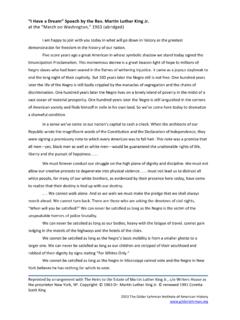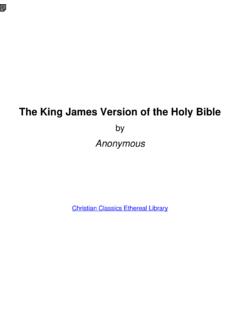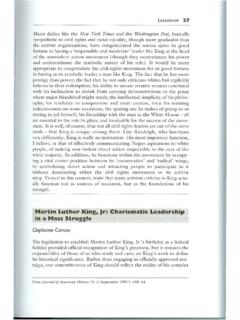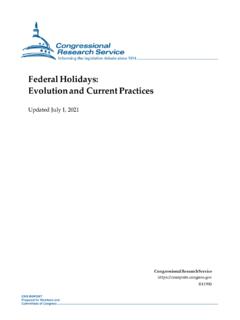Transcription of Using Movies in EFL Classrooms: A Study Conducted at the ...
1 English Language Teaching; Vol. 9, No. 3; 2016 ISSN 1916-4742 E-ISSN 1916-4750 Published by Canadian Center of Science and Education 248 Using Movies in EFL Classrooms: A Study Conducted at the English Language Institute (ELI), king Abdul-Aziz University Raniah Hassen Kabooha1 1 king Abdul Aziz University, Saudi Arabia Correspondence: Raniah Hassen Kabooha, king Abdul Aziz University, Saudi Arabia. E-mail: Received: January 3, 2016 Accepted: February 18, 2016 Online Published: February 22, 2016 doi: URL: Abstract The present Study sought to examine the attitudes of Saudi English as a foreign language (EFL) learners as well as teachers towards the integration of English Movies in their classes as a tool to develop students language skills.
2 Fifty female intermediate level students studying English in their Preparatory Year Program (PYP) in the English Language Institute (ELI) at king Abdul-Aziz University (KAU), Jeddah, Saudi Arabia, participated in the Study . Questionnaires were administered to the students to investigate their perceptions towards the integration of English Movies in their classes to develop their language skills. The researcher also Conducted semi-structured interviews with both students and teachers to explore their perceptions towards the use of Movies in their classes. In addition, teachers were required to write reflective journals regarding the use of Movies in their classes. The findings of the Study indicate that both students as well as teachers had positive attitudes towards the use of Movies in their classes to improve students language skills.
3 The Study offers pedagogical implications for EFL instructors with respect to the integration of films in their classrooms to improve students language learning. Well-selected movie materials could enhance students language learning process and increase their motivation to learn the target language. Keywords: classroom research, language learning, language skills, motivation, Movies , technology. 1. Introduction The acquisition of a second or foreign language is arguably one of the most cognitively challenging undertakings a person may experience in his or her lifetime. In the kingdom of Saudi Arabia, most students have studied English as a foreign language for at least six years before they enter university. Nevertheless, most of them remain incompetent in their ability to use the language.
4 The reasons for this failure are varied and complex. One justification for this issue may be that too much attention has been devoted to intensive reading-analysis of words, sentences and grammar (Al-Akloby, 2001). Many Saudi EFL teachers focus on grammar decoding and skill drilling. In addition, it is been argued that the materials used for teaching the language in most of the Saudi EFL classes are dull and unstimulating. Recently, many language instructors, material designers, and scholars have been interested in investigating the effectiveness of a variety of strategies and methods that can be employed in the EFL classes to facilitate the learners mastery of language skills and optimize the teaching and the learning process.
5 A number of studies have revealed that Movies can become an integral part of the curriculum due to their significant effect on the development of the basic language skills: reading, listening, speaking, and writing (Baratta & Jones, 2008; Mart n & Ja n, 2009; Ismaili, 2013; & Rokni & Ataee, 2014; Yaseen & Shakir, 2015 ). The findings of several studies which have been Conducted to investigate the impact of Using Movies in EFL classrooms indicate their powerful role in the teaching and the learning process. According to Sefero lu (2008), films provide authentic language input and a stimulating framework for classroom discussions. They also provide a realistic view of the language and culture providing insights into the reality of life of native English speakers (Florence, 2009).
6 Studies have also reported some advantages to the integration of Movies into foreign language classes. For instance, Movies can capture the students attention towards the target language (Tognozzi, 2010); increase the students motivation to learn the language (Ruusunen, 2011); supply good material to teach conversations (Mart n & Ja n, 2009); and improve the students awareness of the target language culture (Zhang, 2013). Moreover, the integration of Movies in the EFL/ESL classes can also improve the students academic English Language Teaching Vol. 9, No. 3; 2016 249 writing skills (Baratta & Jones, 2008). Khan (2015) believes that the visuality of Movies can facilitate comprehension and understanding for the language learners in an ideal visual context, which makes it an effective language-teaching tool.
7 She further argues that Movies offer a variety of methods and resources for teaching the target language, helping students to improve their listening and communicative skills. Although, research has indicated the impact of Movies on the development of overall literacy skills (Baratta & Jones, 2008; Mart n & Ja n, 2009; Ismaili, 2013; Rokni & Ataee, 2014), very few works examined the perceptions of EFL teachers and students towards the integration of Movies in their classrooms as a tool to improve students language skills. It should also be noted that there are no studies Conducted in the cultural context of Saudi Arabia. Therefore, the current Study aims at investigating the perceptions of Saudi EFL teachers and students towards integration of Movies into their classrooms as a pedagogical tool to improve students language learning.
8 2. Literature Review A review of the literature on the integration of Movies in the EFL/ESL classrooms provides that Movies are greatly effective in the language classroom for a number of ends. It has been shown that Movies can be exploited in the English classroom to enhance students critical thinking skills (Eken, 2003), their recognition of pragmatic usage and fluency ( king , 2002), and to improve comprehension-based learning (Swaffar & Vlatten, 1997). Movies as a method of teaching have also been found to be an effective motivator for studying language (Sefero lu, 2008; Florence, 2009; & Ismaili, 2013). In addition, Movies teach the students through the use of paralinguistic features where the students use the gestures, pauses, actions, and reactions of the characters to understand the gist of the dialogues (Keene, 2006).
9 They are not only effective motivators, they have also been found to stimulate the imagination of the students (Kusumarasdyati, 2004). Keene (2006) considers Movies unbeatable in providing contextual information and developing interactional skills compared to audio cassettes and CDs. They provide a plethora of knowledge about language providing input in terms of literary, drama, cinema and language aspects thereby promoting critical thinking and other language skills of the students (Eken, 2003, as cited in Keene, 2006). The research Conducted by Pezdek, Lehrer, & Simon (1984) suggests that movie fragments help enhance memory and recovery of information in reading and listening. Film can also help in developing writing skills through providing interesting and motivating clues, assisting in comprehension and production of foreign language input and output (Hanley& Herron, 1995).
10 Another Study that supports the use of Movies in classrooms is that of Herron and Hanley (1992) which concludes that Using Movies offers background information that activates prior knowledge, which is essential in stimulating the four language skills. However, Movies should be chosen with educational objectives in mind. The theme and content should be such that they should not prove to be purely entertainment for the students rather rich in content while being enticing and motivating for the students to watch (Stephens, Ascencio, Burgos, Diaz, Montenegro, & Valenzuela, 2012). Keene (2006) cautions the use of Movies , as they are a technology that is mainly used in the learners home for entertainment, escapism and relaxation all of which encourage a passive form of viewing (p.)

















